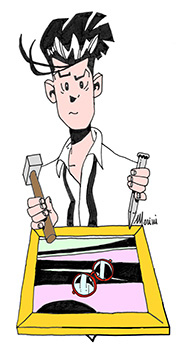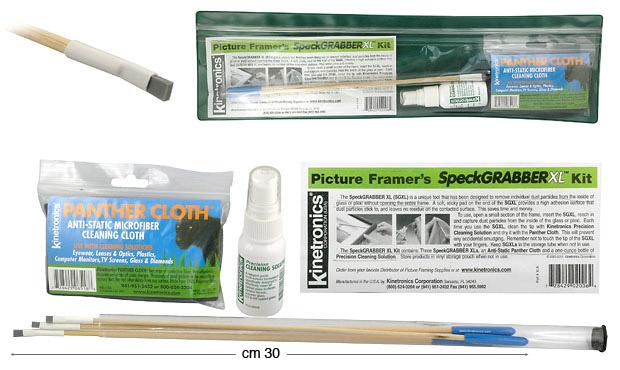A nuisance that a framer from time to time have to face. The articles shows a series of remedies and lists some prevention techniques to avoid it.
Most of you can imagine the following scene. You are about to wrap the framed picture after you have just finished applying the backing paper and your personal label to it when from the corner of your eye you notice... a hair positioned just inside the glass. To make things worse it is sitting right in the middle of one of the mountboard edges. A painful feeling indeed, that all of us have probably experienced. The fact that some surgeons leave medical equipment inside a patient does not really console us. The solution to adopt depends on the various circumstances.
It isn't always a hair that is left in the frame. Sometimes it is a small piece of cardboard, a fragment of glass, a thread of fabric mountboard, some brads or wedges, etc. Even filth from a framer's own clothes can transfer to the framed work.

Each framer may have their own special word to describe these little intruders. American framers often call them "fish" maybe to signify the need to "catch" these items. In order to facilitate things we are going to use the general term "hair" to describe all the various types of filth that can get into a frame.
If the hair is situated at the bottom of the frame, then you could attempt to get it to fall in behind the frame. You may achieve this by shaking the frame or gently tapping on the glass until it falls. However, if the customer was to turn the frame upside down, the hair would most likely reappear. Hence it is a valid solution only if you are able to permanently trap the hair maybe by pressing down the backing board. Another solution could be to get into the back of the frame.
By removing just a few of the staples closest to the hair you may be able to pull back the backing board and then get the hair out by:
|
• |
|
Just letting it drop out. |
|
• |
|
Sucking it out with a vacuum cleaner. |
|
• |
|
Applying a double sided adhesive tape onto the end of a piece of cardboard and fish the hair out (until it sticks to the tape). Plastic could also be used as it is a material when rubbed, creates static electricity and becomes an effective magnet for small items. |
A useful tool for solving this problem is the kit with code 5365, provided by Rinaldin. It is a kit composed of:

The most secure method is to disassemble the frame, clean it thoroughly and reassemble it. This last technique is essential for valued works of art where no risks should be taken.
Better to prevent
A doctor's best medical advice is always "prevention is better than cure". In the framer's case the same principle applies. This can be achieved, above all, by keeping the workplace clean and dust free.
The sawing of mouldings should not take place near the frame assembling workbench. Even if the saw has an aspirator, dust is not totally eliminated but ends up depositing itself on all the objects next to the saw. The workbench should always be kept clean. Wedges, fragments of glass, small pieces of cardboard and so on, all tend to make their way on to the workbench. An aspirator is the best solution. No aspirator means that you will have to resort to pulling up your sleeves and using some elbow grease to rub and brush off these residues.
A framer's own work outfit should be kept clean as it is always in close contact with the frame. Also a framer that is losing hair should be extra careful.
A few handy hints:
|
1. |
|
The hanger should always be applied before applying the picture. If applied afterwards, the knocks from the hammer can violently shake the frame. If the picture has already been applied, then the banging of the hammer can detach any dust and/or fragments from the picture onto the glass. |
|
2. |
|
After having cleaned the glass, it would be handy to go over it with the aspirator in case any of the rag's or paper's particles (whatever was used for cleaning the glass) have remained on the glass. If the glass has already been positioned in the frame, then the cleaning of the glass at this stage tends to accumulate any fragments in the corners. |
|
3. |
|
Pictures, prints, tapestry, etc. should all be cleaned with an aspirator before being inserted into the frame. The use of just a brush can never have the same effect. |
|
4. |
|
After the backing board has been applied, a final use of the aspirator on the back of the frame, is a further guarantee that any fragments will not end up in the frame. |
|
5. |
|
After having completed the frame, don't leave it upside down (facing the floor) for long period of times. Particles of the picture tend to detach (especially if they are charcoals) and deposit themselves on the glass. |